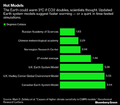File:Climate Models.png: Difference between revisions
Siterunner (talk | contribs) No edit summary |
Siterunner (talk | contribs) No edit summary |
||
| Line 25: | Line 25: | ||
''In the next year, climate-modeling groups will peruse each other’s results to figure out how seemingly good improvements in cloud and aerosol science may have pushed the models into hotter states. These conversations happen in the open, through peer-reviewed journals, conferences and blog posts. The authors of the main UN climate-science reports will follow along and try to stitch together a big picture, for release in 2021... | ''In the next year, climate-modeling groups will peruse each other’s results to figure out how seemingly good improvements in cloud and aerosol science may have pushed the models into hotter states. These conversations happen in the open, through peer-reviewed journals, conferences and blog posts. The authors of the main UN climate-science reports will follow along and try to stitch together a big picture, for release in 2021... | ||
Extreme Projections (RCPs) at Issue | |||
Maybe a More Middling Projection Is in the Cards (or Not) | |||
Do You Feel Lucky? | |||
* https://www.nature.com/articles/d41586-020-00177-3 | |||
Revision as of 22:39, 3 February 2020
<addthis />
Climate Models Are Running Hot -- and Hotter (2020)
How bad is it going to get — and how soon?
There are dozens of climate models, and for decades they’ve agreed on what it would take to heat the planet by about 3° Celsius. It’s an outcome that would be disastrous—flooded cities, agricultural failures, deadly heat—but there’s been a grim steadiness in the consensus among these complicated climate simulations.
Earth-system models are the workhorses of climate research, helping scientists test ideas about the impact of ice-sheet melting, soil moisture and clouds, all without waiting for the actual planet to fall apart. There are more than a hundred models used to forecast the relationship between carbon dioxide and warming, developed by about two dozen independent research groups.
One question modeling can help answer is called “climate sensitivity,” an estimate of how much warmer the planet will be once it has adjusted to atmospheric CO₂ at double the pre-industrial level. (At current rates, CO₂ could reach a doubling point in the last decades of this century.) This is the old, reliable number that’s come out to 3°C for 40 years. It was as close as anything gets to certainty.
Then last year, unnoticed in plain view, some of the models started running very hot. The scientists who hone these systems used the same assumptions about greenhouse-gas emissions as before and came back with far worse outcomes. Some produced projections in excess of 5°C, a nightmare scenario....
Researchers are starting to put together answers, a task that will take months at best, and there’s not yet agreement on how to interpret the hotter results. The reason for worry is that these same models have successfully projected global warming for a half century. Their output continues to frame all major scientific, policy and private-sector climate goals and debates, including the sixth encyclopedic assessment by the UN’s Intergovernmental Panel on Climate Change due out next year. If the same amount of climate pollution will bring faster warming than previously thought, humanity would have less time to avoid the worst impacts.
For now, there are doubts and worries.
In the next year, climate-modeling groups will peruse each other’s results to figure out how seemingly good improvements in cloud and aerosol science may have pushed the models into hotter states. These conversations happen in the open, through peer-reviewed journals, conferences and blog posts. The authors of the main UN climate-science reports will follow along and try to stitch together a big picture, for release in 2021...
Extreme Projections (RCPs) at Issue
Maybe a More Middling Projection Is in the Cards (or Not)
Do You Feel Lucky?
○
File history
Click on a date/time to view the file as it appeared at that time.
| Date/Time | Thumbnail | Dimensions | User | Comment | |
|---|---|---|---|---|---|
| current | 20:49, 3 February 2020 |  | 639 × 558 (123 KB) | Siterunner (talk | contribs) |
You cannot overwrite this file.
File usage
The following 6 pages use this file:
- Air Quality
- Air Pollution
- Agriculture
- Alternative Agriculture
- Antarctica
- Anthropocene
- Arctic
- Atmospheric Science
- City Governments
- Climate Change
- Climate Migration
- Climate Policy
- County Governments
- Desertification
- Digital Citizen
- Earth Imaging
- Earth Observations
- Earth360
- Earth Science
- Earth Science from Space
- Earth System Science
- Ecology Studies
- Eco-nomics
- Education
- Energy
- Environmental Laws
- Environmental Protection
- Environmental Security
- Environmental Security, National Security
- ESA
- European Union
- Externalities
- Extinction
- Florida
- Food
- Forests
- Fossil Fuels
- Greenland
- Global Security
- Global Warming
- Green Networking
- Green Politics
- Health
- INDC
- Maps
- Money in Politics
- NASA
- NOAA
- Natural Resources
- Networking
- New Definitions of National Security
- New Economy
- New Space
- Oceans
- Ocean Science
- Planet Citizen
- Planet Citizens
- Planet Citizens, Planet Scientists
- Rainforest
- Renewable Energy
- Resilience
- Sea-level Rise
- Sea-Level Rise & Mitigation
- Soil
- Solar Energy
- Strategic Demands
- Sustainability Policies
- Threat Multiplier
- United Nations
- US
- US Environmental Protection Agency
- Water Quality
- Whole Earth
- Wind Energy
- World Bank
- World Wide Web
- Youth